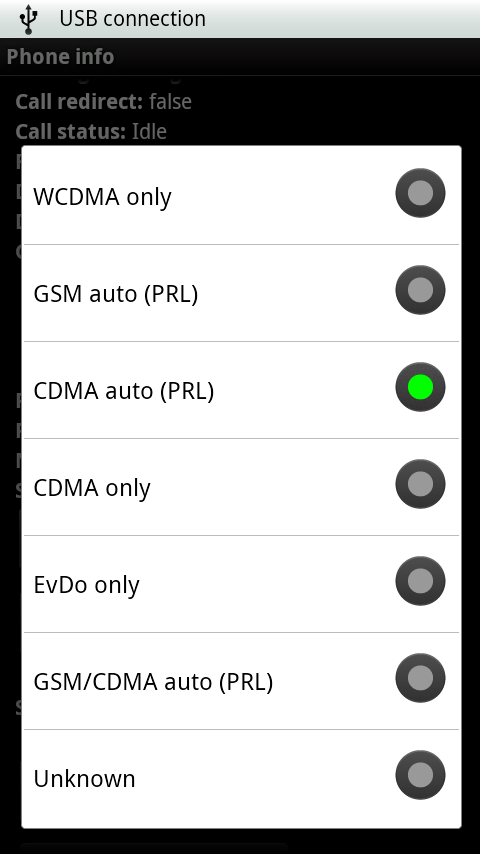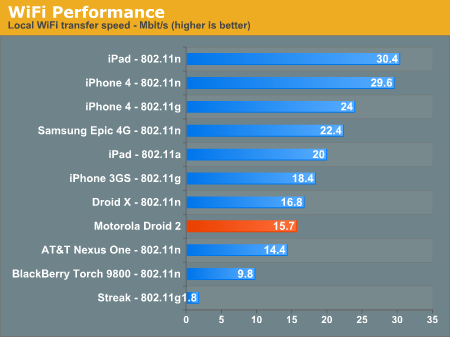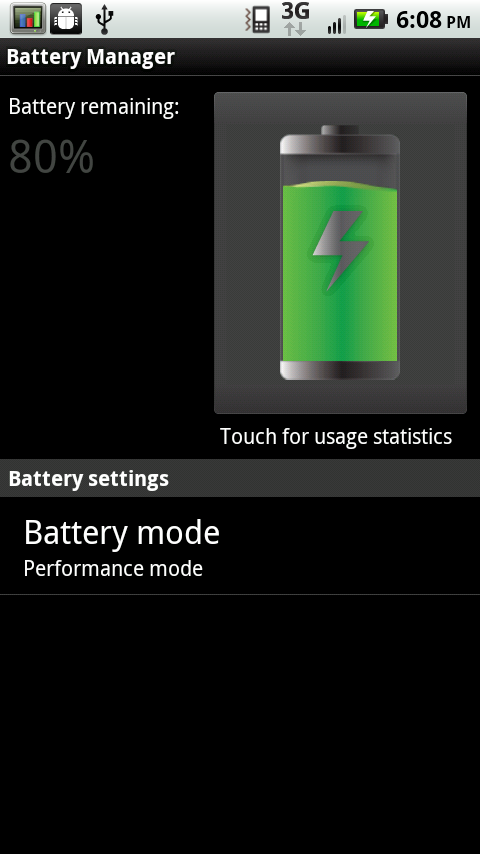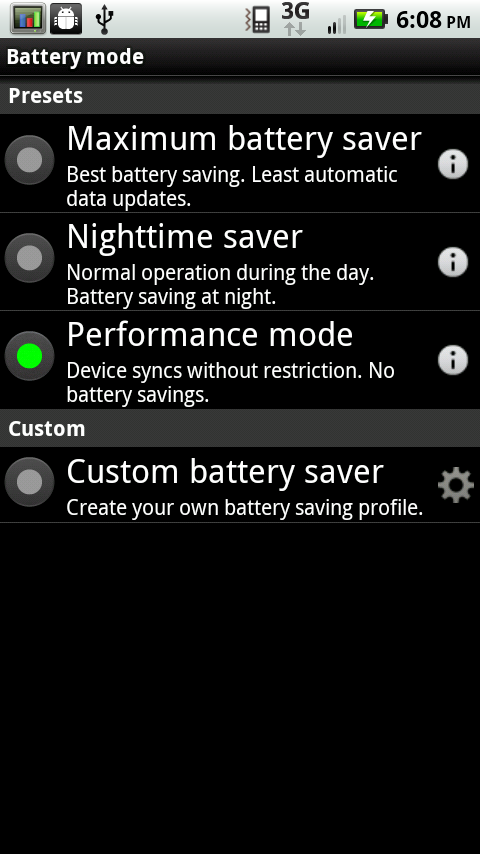Motorola Droid 2 Review: Rebooting the Droid
by Brian Klug on September 19, 2010 7:00 AM EST- Posted in
- Smartphones
- Droid
- Motorola Droid 2
- Android
- Mobile
Cellular and WiFi—Continued
But there’s something else too I believe led to confusion. Motorola has built on the power saving menus and extras they bundled with the Droid X, and the shipping configuration is much more conservative. There’s an extra entry in the settings menu named Battery Manager:
Go inside, and you’ll get a big battery indicator, percentage, a shortcut to see the battery use display Android provides, and something else. Down below is ‘Battery mode’. By default, there are three configurations, and Nighttime saver is selected. Let’s see what it does:
Motorola is basically opting to let you set a schedule for when it should use battery to keep data connections alive. Generally they’re always active, and ready to be used. However, chances are good—if you have a normal sleep cycle—that you won’t use data between sundown and sunrise. Honestly, 10 PM is a bit early for me, as is 5 AM. I won’t even say what hours I’d probably put in here, but basically nothing data is going to happen between these hours by default. Even during setup, there’s a prompt that basically states this has been selected.
You can define your own under custom as well. However if you want the Droid 2 to behave like any other smartphone, select ‘performance mode.’ These titles are somewhat misleading, as none of the three settings appear to actually change system performance—I can still make the Droid 2 run at 1 GHz with load. That behavior remains unchanged. What does is whether the Droid 2 will initiate a data session or sync your accounts.
There’s some benefit to turning data off at night, but only if you don’t regularly plug your phone in before bed. If you’re a smartphone user, you’re probably already in that routine.
I think the introduction of this feature created the primary source of confusion, specifically allegations that data isn’t working as it should be on the Droid 2. I ran just over 100 speedtests on the Droid 2 and averaged 0.715 megabits/s down, and 0.620 megabits/s up on Verizon’s 3G network. The maximum I saw was 2.373 megabits/s down and 1.318 megabits/s up standing about 100 meters with line of sight to a VZW cell tower.
A Lukewarm Hotspot
I didn’t ever have problems with data accessed on the Droid 2 itself. Where I did have massive problems was with tethering on the Droid 2’s built in 3G Mobile Hotspot. Like the Droid X, the Droid 2 has pretty much the same icon and application. In fact, as appearances go, the thing is exactly the same. The difference is that on the Droid X, it worked.
On the Droid 2, my experience was all over the place. I’ve struggled with the Droid 2 hotspot constantly. The problem is that it will just stop working entirely. The hotspot service will pop up with “3G data connection lost”—and the entire hotspot will turn off. It's maddening, every time I was on the go and trying to use the hotspot, I either lacked a USB cable or wasn't quick enough to capture the "3G connection lost" error. It happens so randomly that predicting when the connection is going to drop is nearly impossible.
What’s strange is how sporadic the behavior is. Sometimes the connection will last a solid hour, and be just fine, other times it’ll barely work for 5 minutes. I tested in excellent signal areas, poor signal areas, and with the Droid 2 forced on EV-DO data (no polling of 1x) and forced 1x (slow 2G data) through the *#*#4636#*#* engineering menu—it still drops randomly. I tried all of my laptops and mobile devices, and even swapped through no fewer than three miniPCI-E wireless NICs—it still drops.

This feature is basically broken on the Droid 2. There’s just no other way to state it. If you’re getting the Droid 2 for the built in 3G hotspot feature, reconsider until Verizon and Motorola address it with an OTA update. Or use one of a number solutions from the market, or root. Either way, this was disappointing for me.
Typical WiFi Performance
WiFi performance on the Droid 2 is unsurprisingly on par with the Droid X, as it should be. I saw the Droid 2 negotiate a 65 megabit/s link with a 2x2 802.11b/g/a/n router of mine, which is common for smartphones as we’re starting to see.


GPS is also something a lot of people mentioned regarding the first Droid. When I played with one, I never had fixes take very long, but others did have problems. The Droid 2 thankfully had no issues while testing.
Cold fixes were always speedy as expected. I don’t think anyone will complain about the Droid 2’s GPS performance in all honesty. As always, having WiFi turned on will help get an initial location and speed up the fix, and do a much better job locating you indoors.
















39 Comments
View All Comments
Brian Klug - Sunday, September 19, 2010 - link
Thanks for calling me out on that, I totally suspected I had forgotten something important. Can't believe I did that. /facepalm-Brian
stlc8tr - Sunday, September 19, 2010 - link
"The Droid 2 has pulled a complete 180 from the original Droid’s travesty of a keyboard. I’d say the device has gone from having one of the industry’s worst smartphone keyboards to arguably one of the best, if not the best. "Really? Have you tried the Touch Pro2 keyboard? Good travel. Nice offset. Numbers row. Good spacing between keys. It's nearly perfect. That is by far the best keyboard that I've ever used.
http://www.mobileguerilla.com/images/htc-touch-pro...
Brian Klug - Sunday, September 19, 2010 - link
I had a Touch Pro and Touch Pro 2 for a long time. I have to agree - HTC has dominated the landscape keyboard landscape for a while, but on Android platform it's hard to beat the Droid 2 right now.Until we get the landscape HTC device that we've seen spy shots of. I don't think it has a codename yet, but it has that Touch Pro 2 keyboard.
I think we definitely agree.
-Brian
wyvernknight - Sunday, September 19, 2010 - link
I think the blur animation that you're talking about when you open and close the app drawer is simply a stock Android 2.2 animation and not a Motoblur add-on.hansel2099 - Sunday, September 19, 2010 - link
muy buen celularlunarx3dfx - Sunday, September 19, 2010 - link
This is very disappointing. Your reviews are always very informative and for the most part all inclusive, but I've noticed in the last few reviews the Palm Pre has been absent. Now, I know that most would say, well it's Palm, and they are pretty much dead. However, unlike the Nexus One, which is included in all these reviews, I'm sure there were more Pre's sold than the Nexus One meaning that there are probably a few consumers out there that would like to see how it stacks compared to a new phone that they might be considering. It's just a suggestion.Also, for those who might be wondering, my overclocked to 1 GHz Palm Pre scored as follows:
Browsermark: 24492
Sunspider: 11228
I'd like to point out that those scores are still pretty high up on the list.
Brian Klug - Sunday, September 19, 2010 - link
Hey lunarx3dfx, I've got a Palm Pre Plus here that we got in for review, so I haven't really been able to include benchmarks from those suites until now. It'll show up in the new benchmarks though. On stock clocks I get 22298 ms on sunspider and 12936 on browsermark. Those 1 GHz speeds are actually pretty impressive.-Brian
ol1bit - Sunday, September 19, 2010 - link
I think it's awesome that you are reviewing Smart Phones now. After all, they are truning more and more into computers.I've been into computers since the TSR-80 Color computer, and can't believe how far things have advances. http://oldcomputers.net/coco.html
Anyway Thank You!
AnnonymousCoward - Sunday, September 19, 2010 - link
Brian, I commend you for this engineering review and attention to detail. You made some great observations, like the ridiculous waste of space when text messaging.The inability to delete the stupid verizon and google bookmarks is inexcusable. Not mentioned is also the inability to delete or even just hide the garbage apps that come by default, including Blockbuster and Amazon MP3. So much for "Droid Does". Droid Doesn't let you delete the preinstalled crap. Besides rooting of course.
I noticed in a Verizon store using the X with the 2 side-by-side that the 2 has noticeably worse scrolling performance in the app list.
As for that 1cm of empty space to the right of the keyboard, they should have used that to make the keyboard even bigger! It was wasted, in order to have the phone dip down 2mm near the edge, which really doesn't accomplish anything.
A huge gripe I have is how syncing with facebook causes your entire contact list to be overtaken. The only remedy seems to be not not add facebook as an account, and give yourself a link to facebook.com on your desktop.
I am disappointed with the ever-present touch screen lag. Clicking and scrolling anything has a lagged effect from your input. Unfortunately, many people lack lag sensitivity, so we end up with displays and phones that exhibit an acceptable amount of lag to a few designers or testers, which is unacceptable to guys like me.
evilspoons - Sunday, September 19, 2010 - link
I find it amusing how you're talking about the Droid 1 as if it's a dinosaur from the land of ancient, forgotten technology... yet it's still a year newer than the Blackberry I use all the time (Nov 2009 vs Aug 2008). Hmmm. Maybe it's time to upgrade.Only one of the local wireless carriers has the Droid 1 (sold as the Milestone because Droid is licensed to Verizon from Lucasfilm) and we just got it recently. The only recent-ish Android phone my current provider (Rogers) has is the Xperia X10. Ugh.
It's really just an iPhone 4 or a 6-12 month out-of-date handset for us up in the Great White North.